Date of log: 03 Feb 2011, 8pm
Location: In the crew's cabin of the Rocket, obtained after much haggling, en route to Hularhat
I lie in my comfy white linen bed, rightly meant for a crew member aboard the 1950s paddle steamer "Mahsud", one of 4 owned by the Bangladesh Inland Waterway Transport Corporation (BIWTC), collectively known as the "Rocket" writing this entry. There were no more 1st class or 2nd class tickets for sale, which meant a free for all deck class rush for sleeping space with the locals. But as always, there was a way out. The common solution is to offer the foreign tourist the cabin crew's room, and charge him a handsome premium for it. By our standards though, the 800 taka i paid (excluding the 120 taka deck class ticket) for the privacy, clean sheets and most importantly, a power outlet to recharge all my flashpacking toys, was a very fair price.
The day started with me taking one of the overpriced airport taxis (700 taka to Gulshan 1). I was to meet Mahmud, the local contact I had been communicating with, prior to this trip. He is described in the Lonely Planet as the patron saint of travelers in Bangladesh, going out of his way to ensure first time budget travelers are able to find their way around when they step foot into Dhaka. So Mahmud told me to meet him in the lobby of Hotel Washington, located near Gulshan circle 1, the upscale suburb of Dhaka where all the embassies are located. He does this helping out travelers thing in his spare time, and for this instance with me, it was still a working day. And so, after breakfast (prata!), he led me to his office, where he has a very respectable day job as a manager. He went through roughly my itinerary and advised me to get a ticket at BIWTC's office in Motijheel area before doing any sightseeing in Dhaka, since I needed to be out on the Rocket to Hularhat on the same evening. Mahmud also helped me coordinate to meet a man from Entree Tours, with whom I made the advance payment for my daylong trip in the Sundarbans, planned for the 5th Feb. Oh, and I went from breakfast to Mahmud's office by way of a rickshaw, pulled by the rickshaw-wallah.
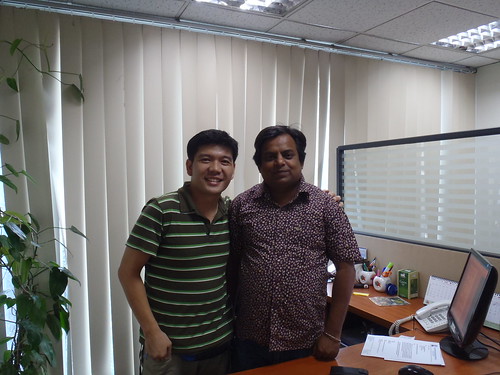
I traveled to the BIWTC office on a CNG. So named for the fuel source they run on, the CNGs are actually tuk-tuks commonly found elsewhere in Asia. The Bangladeshi version however has the passenger fully enclosed in a cage. The trip price was intially agreed upon at 100 taka. The CNGs have meters, though the drivers loathe using them, often raising the ire of the local police in the process. Saying that, my driver had his meter running, possibly to fool any cop who checks on his ride. Hence began my first introduction to Dhaka road, and the jams. My 10 km ride took almost an hour, and I don't think my bearded driver expected the jam, by the end of the ride, my meter actually exceeded the 100 taka we agreed upon! I paid him the meter price and a tip (120 taka in all). Inside the cage, I looked out and took various photos, as well as shots of my driver doing his best impression of spiderman hanging on to the cage walls. Yes, we had that much time to kill while sitting in the jam.
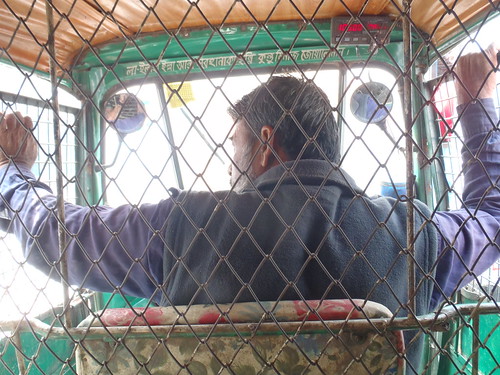

I do ask myself however, how do traffic cultures in cities develop? For instance, here in Dhaka, everyone horns, and slots their vehicles into little nooks and each others lanes. Elsewhere, the former is absent, no one horns, even though they do the same dance on the roads. Vehicles here run the gamut: CNGs, rickshaws, cars, trucks, all. Yet on long stretches of road jams, only scores of rickshaws are seen lined in series, obidiently waiting for the one up front to move forward.
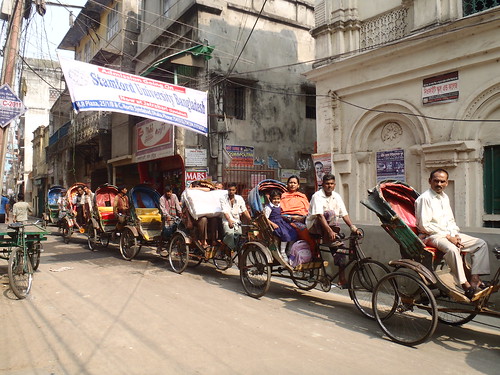
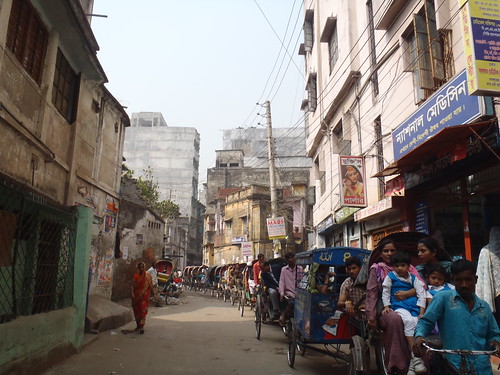
I finally hit the BIWTC office one full hour later. And to my dismay, the officer in charge says that the weekend is coming, so all the 1st and 2nd class tickets were full. He recommends that I go down the boat pier early, around 5pm to get a deck class ticket, and see if I can trade for a crew members' room, which is the arrangement they normally make for pesky foreigners (like me) who makes last minute bookings and who would probably wither and die should they be made to stay under deck class conditions.
I lamented my situation to P, a 60 year young englishman I met in the BIWTC. He is booking a Rocket ticket for the coming Monday (now why can't all foreigners be like this man, booking in advance). P tells me that he has been in Bangladesh for the past two weeks, mainly in the Chittagong region, and I am the first non Bangla or Indian he has met in two weeks. So i guess I shouldnt be expecting to meet any other travelers soon. I decided to accompany P, since we were both the doing Old Dhaka part of the city, for the rest of the day. Actually, I accompanied P because he had more of a plan than I did. P planned in detail where exactly he wanted to go and what he wanted to see, a full 8 months ago. Me, I only had a gist of where to go, thought of yesterday on the plane and was fully prepared to get lost in the streets. =)
And so, we took a rickshaw to the starting point of our Old Dhaka walk. This was the Sutrapur area, which passed through old colonial architecture of the early 1900s. It was an assault on the senses. Rickshaw wallahs calling on you to move off the road, the smell of dried chilli, ginger and onions making me tear and sneeze, colourful pieces of cloth neatly stacked atop each other, locals calling out to us, and eyeing us with curiosity as we stood admiring the architecture of buildings. My humble writing fails to elaborately describe the sights, sounds and smells that is Old Dhaka.
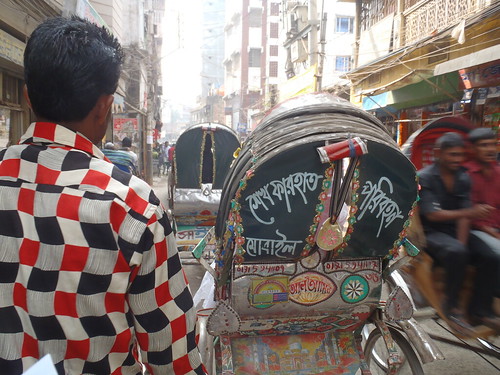

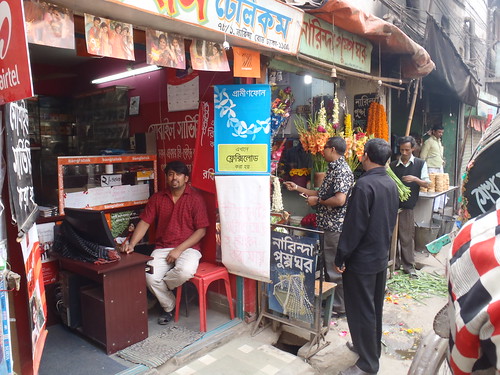
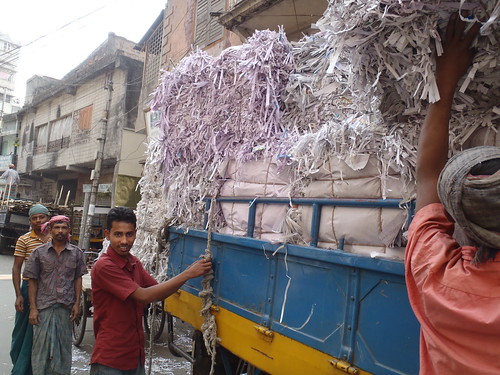
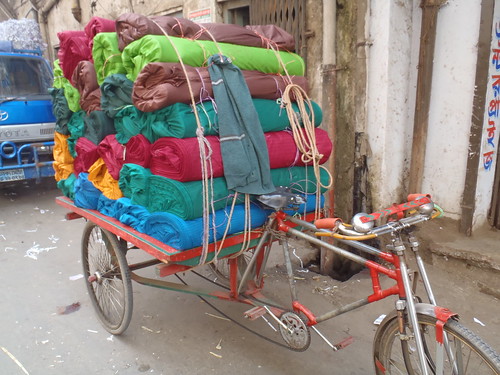
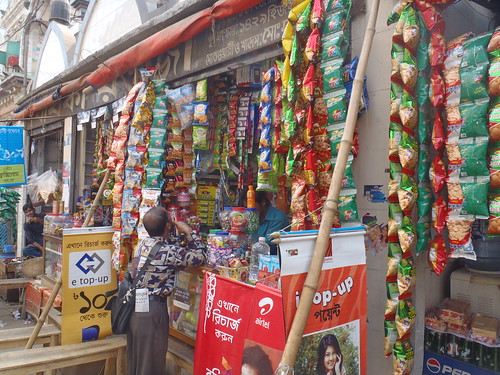
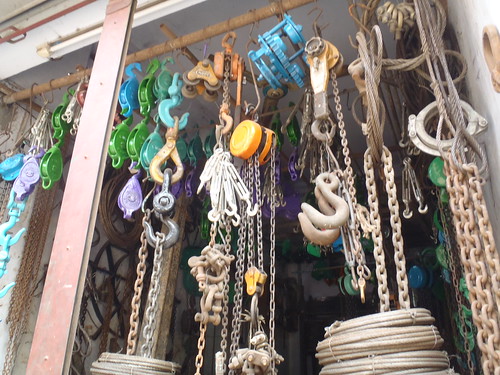



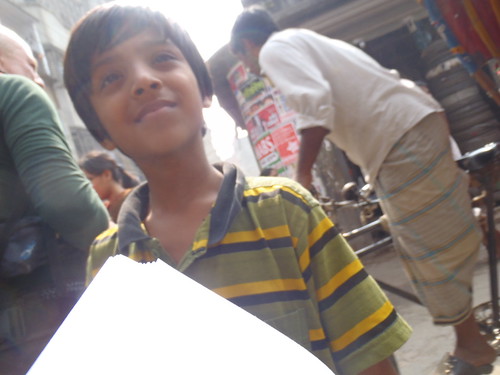
From the Sutrapur area, we headed down the the Sadarghat docks, from where we got a full view of the Buriganga River. The river teems with life. Boats of all shapes and sizes can be found. Small boats carrying passengers were being ferried across the large river to the other bank, huge Launches were moored on the banks. Everyday life goes on here, Goods are undocked, players gamble on the ground by the river, rickshaws drop their passengers at the pier. Here was also the embarkation point for the Rocket later this afternoon.

We carry on. There is just so much going on. Chapatis sizzle in the roadside shops, skull-capped old men in red beards greet you with a smile, the occasional kid eager to practise his English trails you. After a while, you get used to it and go with the flow. The sight of a jam, both vehicular and human on a four way junction doesnt bother you anymore. Even though all the vehicles are stationary, with seemingly no way to get out of the situation, the locals band together to direct each vehicle out. For us, we smile, step over bicycle front tires, swing around CNGs and hop across vehicle cargo, and make our way.
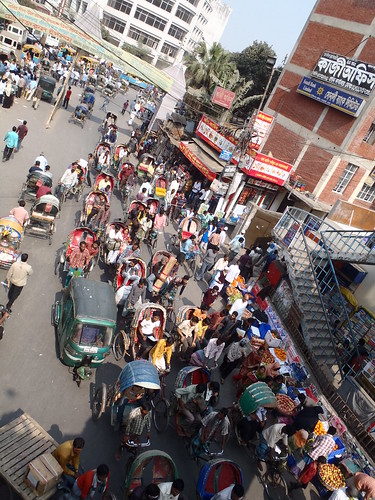
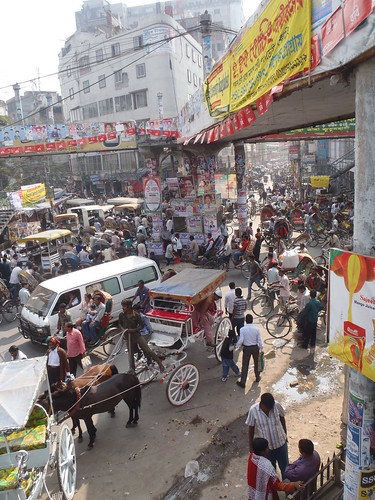

Down past Islampur Street, the roads widen slightly, meaning I don't have to fight with rickshaws for road space any longer. We were looking for the building known as Ahsan Manzil, also called the Pink Palace, so named for its pink outer facade. Built by a wealthy landowner and restored in the late 80s, it is one of the more interesting structures. It was closed on Thurdays though, so we didn't get a closer look, beyond the steel grated fence.
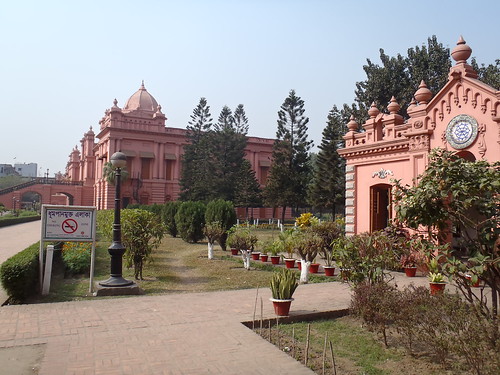
The next two sights were the Armenian Church, and the Sitara Mosque, both fascinating and a tranquil contrast to the bustling cacophony of sounds outside their grounds. The former, for the well preserved structure, maintained by the caretaker of an extinct community in Dhaka, and the latter, for the slightly tacky stars painted all over the dome and walls of the mosque.

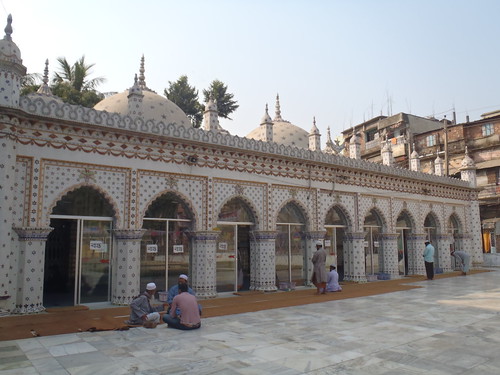
We then decided to stop (for a 60 year old, P has impressive stamina, he could go on and on, and I was trying my best to keep up) at Haji Beriyani, an eatery around the Nazira Market area, recommended by P's Bradt guide. Between the two of us, and our LP and Bradt guides, we were able to navigate Old Dhaka pretty well, through a combination of asking locals for directions and reading the occasional shop sign whose address and road name is spelled out in English. However, we had trouble finding the Haji Beriyani eatery, going back through and fro, before realising from helpful locals that the shop was closed.Instead we headed to Al-Razzaque, crowded, so obviously a good place, with better hygiene levels than most of the roadside stalls we passed by. The chicken beriyani was excellent. Different from the usual fare back home, it is not yellow, more of the pilau type commonly found out of Singapore. The cost, a friendly 150 taka including drinks, barely 3 SGD.

I bade P farewell then, for I had to go down to Saderghat and get my Rocket ticket. Even though the river was not too far south, I headed there earlier, for the Dhaka road traffic jams were legendary, and between 4 to 7pm were the worst. I scampered on the sidewalks and slowly edged my way to the pier, roughly a half hour to travel less than 1 km. And that was fast. If I had taken a rickshaw it would probably take me till dark.
Expectedly, I could only get a deck class ticket for 120 taka. I got aboard and was promptly offered the crew's cabin for 800 taka for a trip up to Hularhat. This was roughly the price of a 1st class ticket, with two beds in a cabin. Mine was a simple 2x2m room with just a bed and not much else, but its luxury to me. I agreed without bargaining, and i think the guy felt that he should have asked for more, and upped the price to 900 taka. When traveling, negotiate with a smile and a firm no, that normally allows you to get your way. "900 taka, nahhhh, you said 800 earlier. I agreed. If you say 900 taka, then now I will bargain for 700 taka. Yes? It's ok? 800? Good man." Smiling all the way.

The Rocket is a paddle steamer, those kind you read about traveling down the Mississippi River, built in the 1950s. Old, run down yet having a certain charm about it, traveling down the river in a Rocket remains on of the quintisssential things to do for a traveler in Bangladesh. There are two levels to the steamer, the lower level is the deck class, where everyone stakes their place on the floor or bench and lays down a mat. Later on, I would see them eating their meals on the floor and asleep wrapped up in blankets. It gets very cold at night this time of year. My bunk is on this level, tucked in one unobtrusive corner. Upstairs is the 1st class and 2nd class area. The first class area, I took a peek, comprises nice comfy rooms opening out to the 1st class dining area. The 2nd class area was out in the back, but both have balconies so you can look out the either shoreline. There is an upstairs deck area, out of bounds to non-1st class passengers, which I'll probably explore tomorrow morning.
I had dinner in the 1st class dining area, got served by a waiter, 4 dishes, yellow rice, with cutlery arranged in western setting. The price, less than 4 SGD (180 taka). In the dining area, were the 1st class passengers, locals, too but well-dressed cultured types who talk about the news and politics and sports, switching between Bengali and English. It's in stark contrast to the deck below, where everyone else were huddled in blankets to keep warm. There is probably an income disparity here in Bangladesh, where more than 50% of the population lives below the poverty line, earning less than 50 taka (1 SGD) a day. Things are improving though, at least in Dhaka. Children go to school, the infant mortality rate is dropping, birth rates under control, gender equality is on the rise. Yet as the locals tell it, there is still much to be done. Me? I had my fill, tipped the waiter, and headed back downstairs to MY blanket to keep warm.
Location: In the crew's cabin of the Rocket, obtained after much haggling, en route to Hularhat
I lie in my comfy white linen bed, rightly meant for a crew member aboard the 1950s paddle steamer "Mahsud", one of 4 owned by the Bangladesh Inland Waterway Transport Corporation (BIWTC), collectively known as the "Rocket" writing this entry. There were no more 1st class or 2nd class tickets for sale, which meant a free for all deck class rush for sleeping space with the locals. But as always, there was a way out. The common solution is to offer the foreign tourist the cabin crew's room, and charge him a handsome premium for it. By our standards though, the 800 taka i paid (excluding the 120 taka deck class ticket) for the privacy, clean sheets and most importantly, a power outlet to recharge all my flashpacking toys, was a very fair price.
The day started with me taking one of the overpriced airport taxis (700 taka to Gulshan 1). I was to meet Mahmud, the local contact I had been communicating with, prior to this trip. He is described in the Lonely Planet as the patron saint of travelers in Bangladesh, going out of his way to ensure first time budget travelers are able to find their way around when they step foot into Dhaka. So Mahmud told me to meet him in the lobby of Hotel Washington, located near Gulshan circle 1, the upscale suburb of Dhaka where all the embassies are located. He does this helping out travelers thing in his spare time, and for this instance with me, it was still a working day. And so, after breakfast (prata!), he led me to his office, where he has a very respectable day job as a manager. He went through roughly my itinerary and advised me to get a ticket at BIWTC's office in Motijheel area before doing any sightseeing in Dhaka, since I needed to be out on the Rocket to Hularhat on the same evening. Mahmud also helped me coordinate to meet a man from Entree Tours, with whom I made the advance payment for my daylong trip in the Sundarbans, planned for the 5th Feb. Oh, and I went from breakfast to Mahmud's office by way of a rickshaw, pulled by the rickshaw-wallah.

I traveled to the BIWTC office on a CNG. So named for the fuel source they run on, the CNGs are actually tuk-tuks commonly found elsewhere in Asia. The Bangladeshi version however has the passenger fully enclosed in a cage. The trip price was intially agreed upon at 100 taka. The CNGs have meters, though the drivers loathe using them, often raising the ire of the local police in the process. Saying that, my driver had his meter running, possibly to fool any cop who checks on his ride. Hence began my first introduction to Dhaka road, and the jams. My 10 km ride took almost an hour, and I don't think my bearded driver expected the jam, by the end of the ride, my meter actually exceeded the 100 taka we agreed upon! I paid him the meter price and a tip (120 taka in all). Inside the cage, I looked out and took various photos, as well as shots of my driver doing his best impression of spiderman hanging on to the cage walls. Yes, we had that much time to kill while sitting in the jam.


I do ask myself however, how do traffic cultures in cities develop? For instance, here in Dhaka, everyone horns, and slots their vehicles into little nooks and each others lanes. Elsewhere, the former is absent, no one horns, even though they do the same dance on the roads. Vehicles here run the gamut: CNGs, rickshaws, cars, trucks, all. Yet on long stretches of road jams, only scores of rickshaws are seen lined in series, obidiently waiting for the one up front to move forward.


I finally hit the BIWTC office one full hour later. And to my dismay, the officer in charge says that the weekend is coming, so all the 1st and 2nd class tickets were full. He recommends that I go down the boat pier early, around 5pm to get a deck class ticket, and see if I can trade for a crew members' room, which is the arrangement they normally make for pesky foreigners (like me) who makes last minute bookings and who would probably wither and die should they be made to stay under deck class conditions.
I lamented my situation to P, a 60 year young englishman I met in the BIWTC. He is booking a Rocket ticket for the coming Monday (now why can't all foreigners be like this man, booking in advance). P tells me that he has been in Bangladesh for the past two weeks, mainly in the Chittagong region, and I am the first non Bangla or Indian he has met in two weeks. So i guess I shouldnt be expecting to meet any other travelers soon. I decided to accompany P, since we were both the doing Old Dhaka part of the city, for the rest of the day. Actually, I accompanied P because he had more of a plan than I did. P planned in detail where exactly he wanted to go and what he wanted to see, a full 8 months ago. Me, I only had a gist of where to go, thought of yesterday on the plane and was fully prepared to get lost in the streets. =)
And so, we took a rickshaw to the starting point of our Old Dhaka walk. This was the Sutrapur area, which passed through old colonial architecture of the early 1900s. It was an assault on the senses. Rickshaw wallahs calling on you to move off the road, the smell of dried chilli, ginger and onions making me tear and sneeze, colourful pieces of cloth neatly stacked atop each other, locals calling out to us, and eyeing us with curiosity as we stood admiring the architecture of buildings. My humble writing fails to elaborately describe the sights, sounds and smells that is Old Dhaka.











From the Sutrapur area, we headed down the the Sadarghat docks, from where we got a full view of the Buriganga River. The river teems with life. Boats of all shapes and sizes can be found. Small boats carrying passengers were being ferried across the large river to the other bank, huge Launches were moored on the banks. Everyday life goes on here, Goods are undocked, players gamble on the ground by the river, rickshaws drop their passengers at the pier. Here was also the embarkation point for the Rocket later this afternoon.

We carry on. There is just so much going on. Chapatis sizzle in the roadside shops, skull-capped old men in red beards greet you with a smile, the occasional kid eager to practise his English trails you. After a while, you get used to it and go with the flow. The sight of a jam, both vehicular and human on a four way junction doesnt bother you anymore. Even though all the vehicles are stationary, with seemingly no way to get out of the situation, the locals band together to direct each vehicle out. For us, we smile, step over bicycle front tires, swing around CNGs and hop across vehicle cargo, and make our way.



Down past Islampur Street, the roads widen slightly, meaning I don't have to fight with rickshaws for road space any longer. We were looking for the building known as Ahsan Manzil, also called the Pink Palace, so named for its pink outer facade. Built by a wealthy landowner and restored in the late 80s, it is one of the more interesting structures. It was closed on Thurdays though, so we didn't get a closer look, beyond the steel grated fence.

The next two sights were the Armenian Church, and the Sitara Mosque, both fascinating and a tranquil contrast to the bustling cacophony of sounds outside their grounds. The former, for the well preserved structure, maintained by the caretaker of an extinct community in Dhaka, and the latter, for the slightly tacky stars painted all over the dome and walls of the mosque.


We then decided to stop (for a 60 year old, P has impressive stamina, he could go on and on, and I was trying my best to keep up) at Haji Beriyani, an eatery around the Nazira Market area, recommended by P's Bradt guide. Between the two of us, and our LP and Bradt guides, we were able to navigate Old Dhaka pretty well, through a combination of asking locals for directions and reading the occasional shop sign whose address and road name is spelled out in English. However, we had trouble finding the Haji Beriyani eatery, going back through and fro, before realising from helpful locals that the shop was closed.Instead we headed to Al-Razzaque, crowded, so obviously a good place, with better hygiene levels than most of the roadside stalls we passed by. The chicken beriyani was excellent. Different from the usual fare back home, it is not yellow, more of the pilau type commonly found out of Singapore. The cost, a friendly 150 taka including drinks, barely 3 SGD.

I bade P farewell then, for I had to go down to Saderghat and get my Rocket ticket. Even though the river was not too far south, I headed there earlier, for the Dhaka road traffic jams were legendary, and between 4 to 7pm were the worst. I scampered on the sidewalks and slowly edged my way to the pier, roughly a half hour to travel less than 1 km. And that was fast. If I had taken a rickshaw it would probably take me till dark.
Expectedly, I could only get a deck class ticket for 120 taka. I got aboard and was promptly offered the crew's cabin for 800 taka for a trip up to Hularhat. This was roughly the price of a 1st class ticket, with two beds in a cabin. Mine was a simple 2x2m room with just a bed and not much else, but its luxury to me. I agreed without bargaining, and i think the guy felt that he should have asked for more, and upped the price to 900 taka. When traveling, negotiate with a smile and a firm no, that normally allows you to get your way. "900 taka, nahhhh, you said 800 earlier. I agreed. If you say 900 taka, then now I will bargain for 700 taka. Yes? It's ok? 800? Good man." Smiling all the way.

The Rocket is a paddle steamer, those kind you read about traveling down the Mississippi River, built in the 1950s. Old, run down yet having a certain charm about it, traveling down the river in a Rocket remains on of the quintisssential things to do for a traveler in Bangladesh. There are two levels to the steamer, the lower level is the deck class, where everyone stakes their place on the floor or bench and lays down a mat. Later on, I would see them eating their meals on the floor and asleep wrapped up in blankets. It gets very cold at night this time of year. My bunk is on this level, tucked in one unobtrusive corner. Upstairs is the 1st class and 2nd class area. The first class area, I took a peek, comprises nice comfy rooms opening out to the 1st class dining area. The 2nd class area was out in the back, but both have balconies so you can look out the either shoreline. There is an upstairs deck area, out of bounds to non-1st class passengers, which I'll probably explore tomorrow morning.
I had dinner in the 1st class dining area, got served by a waiter, 4 dishes, yellow rice, with cutlery arranged in western setting. The price, less than 4 SGD (180 taka). In the dining area, were the 1st class passengers, locals, too but well-dressed cultured types who talk about the news and politics and sports, switching between Bengali and English. It's in stark contrast to the deck below, where everyone else were huddled in blankets to keep warm. There is probably an income disparity here in Bangladesh, where more than 50% of the population lives below the poverty line, earning less than 50 taka (1 SGD) a day. Things are improving though, at least in Dhaka. Children go to school, the infant mortality rate is dropping, birth rates under control, gender equality is on the rise. Yet as the locals tell it, there is still much to be done. Me? I had my fill, tipped the waiter, and headed back downstairs to MY blanket to keep warm.
Hi Red,
ReplyDeleteJoanne here. Thanks for the tips on how to set up pages. I love travel too! Although a difference in style - yours is rather adventurous. I am starting a travel blog with a different theme, and I hope to share it with you.
http://www.yourtravelbeacon.blogspot.com/